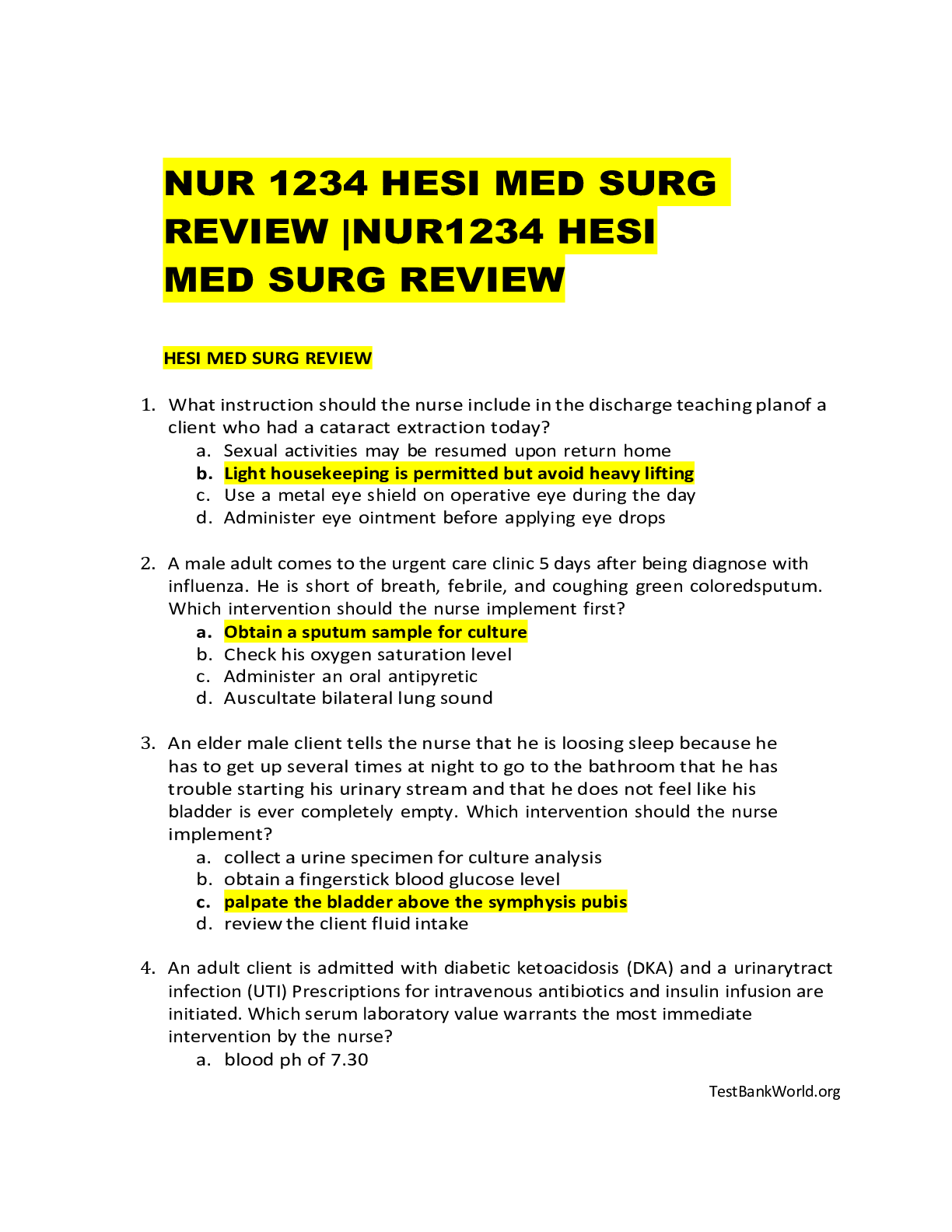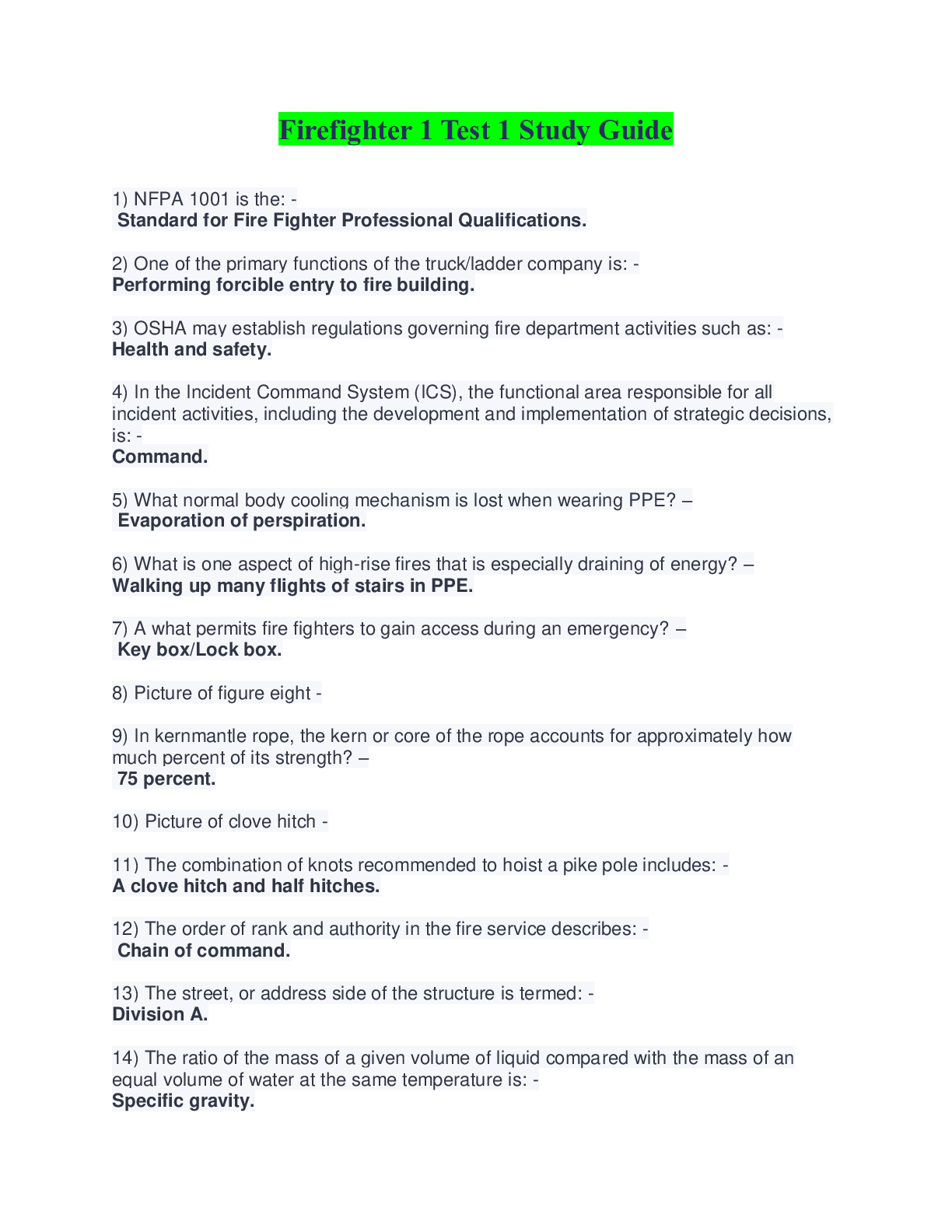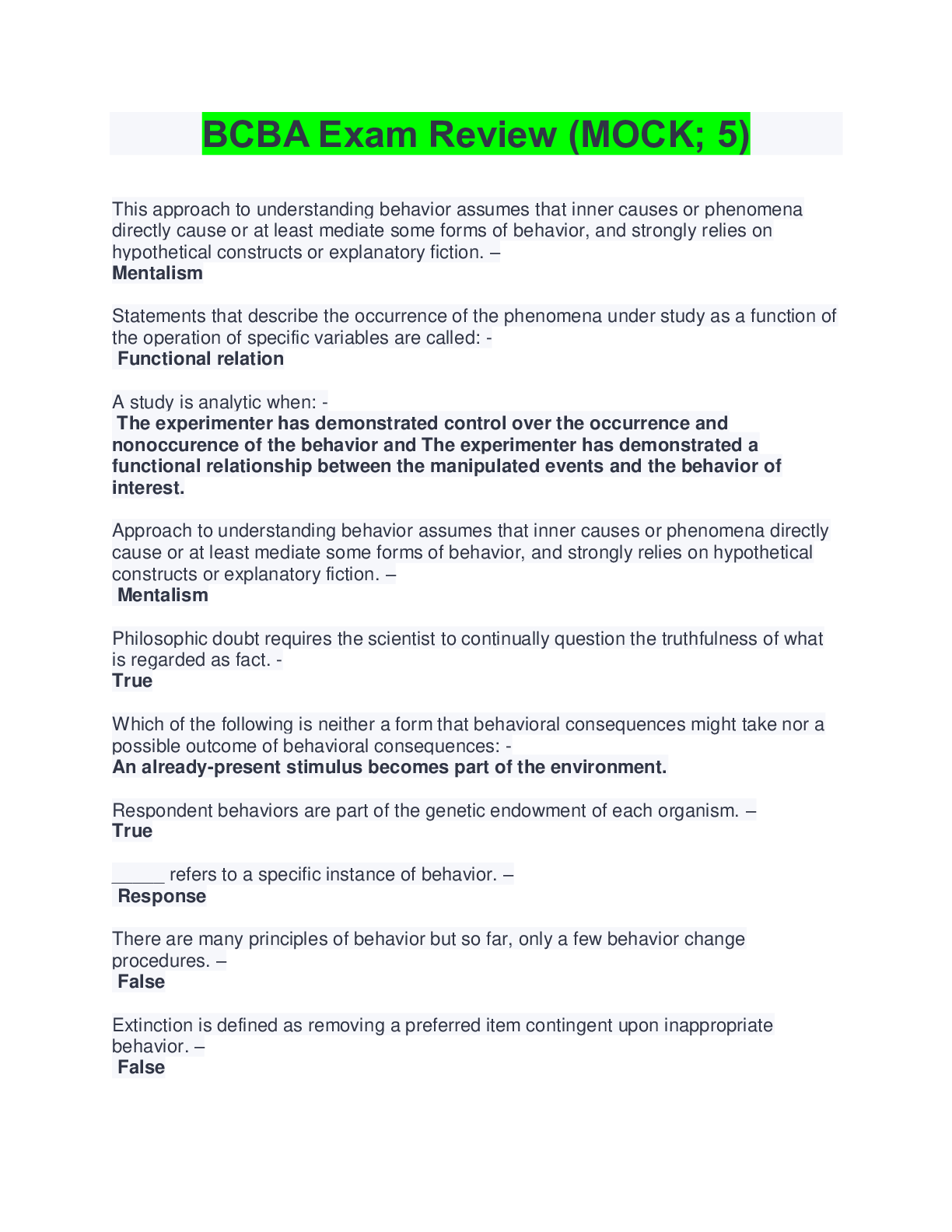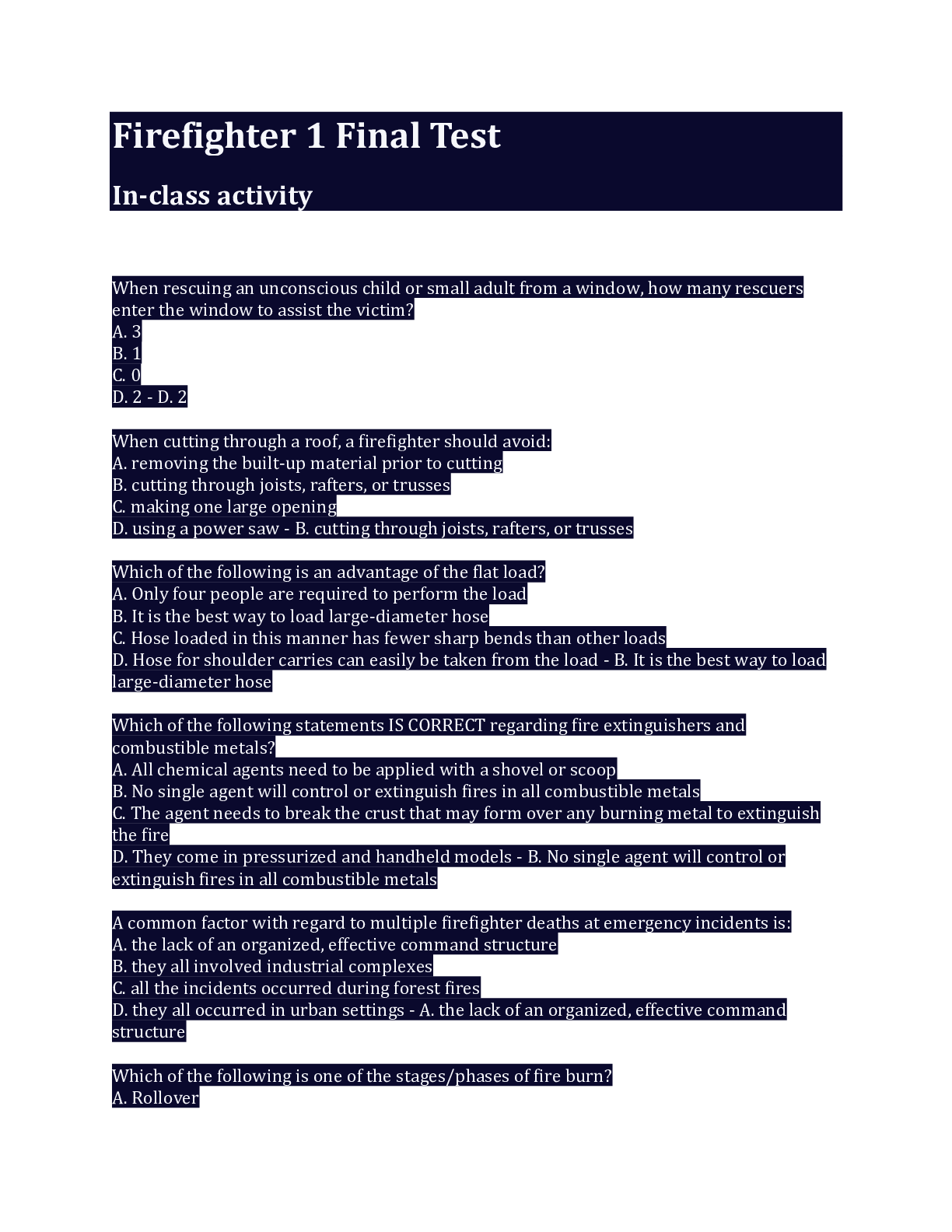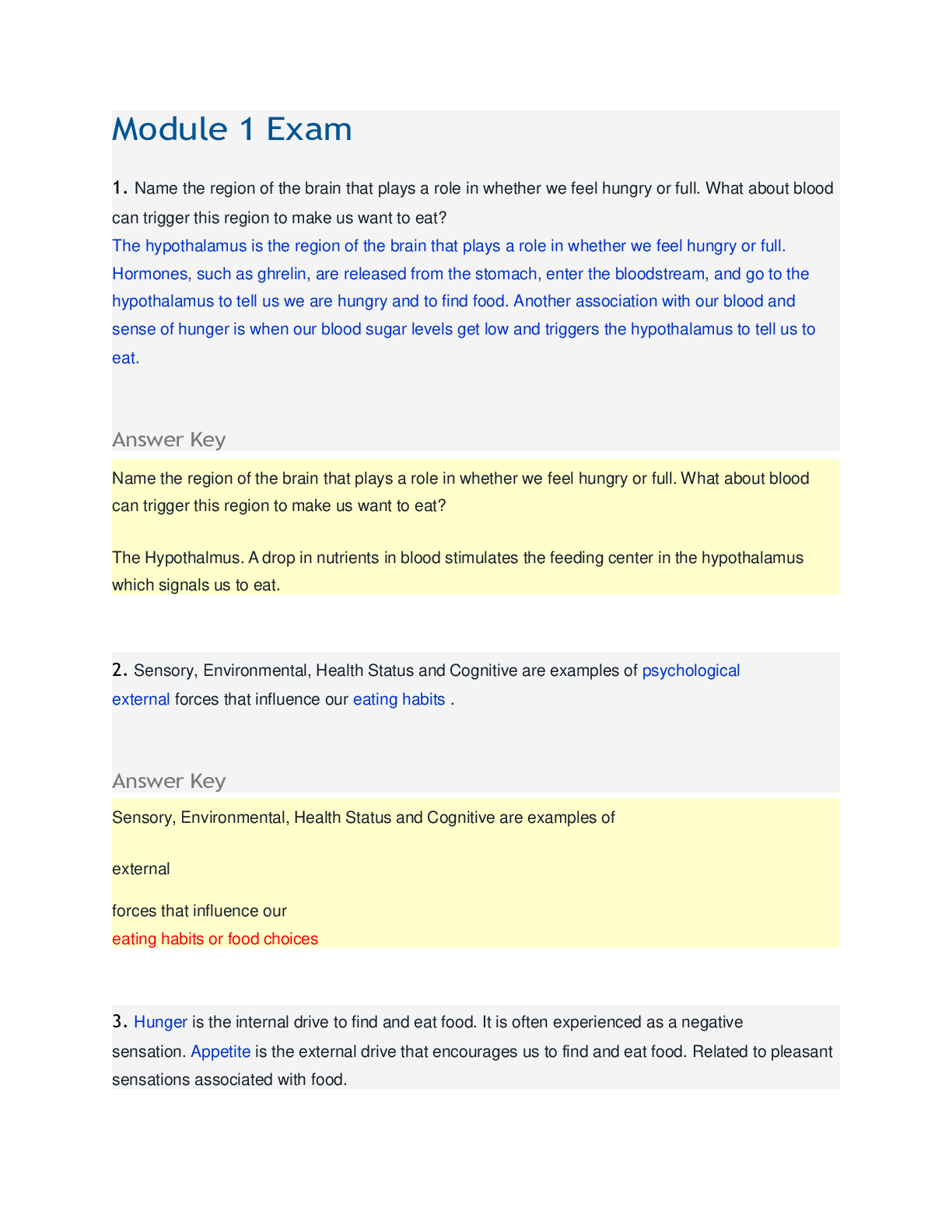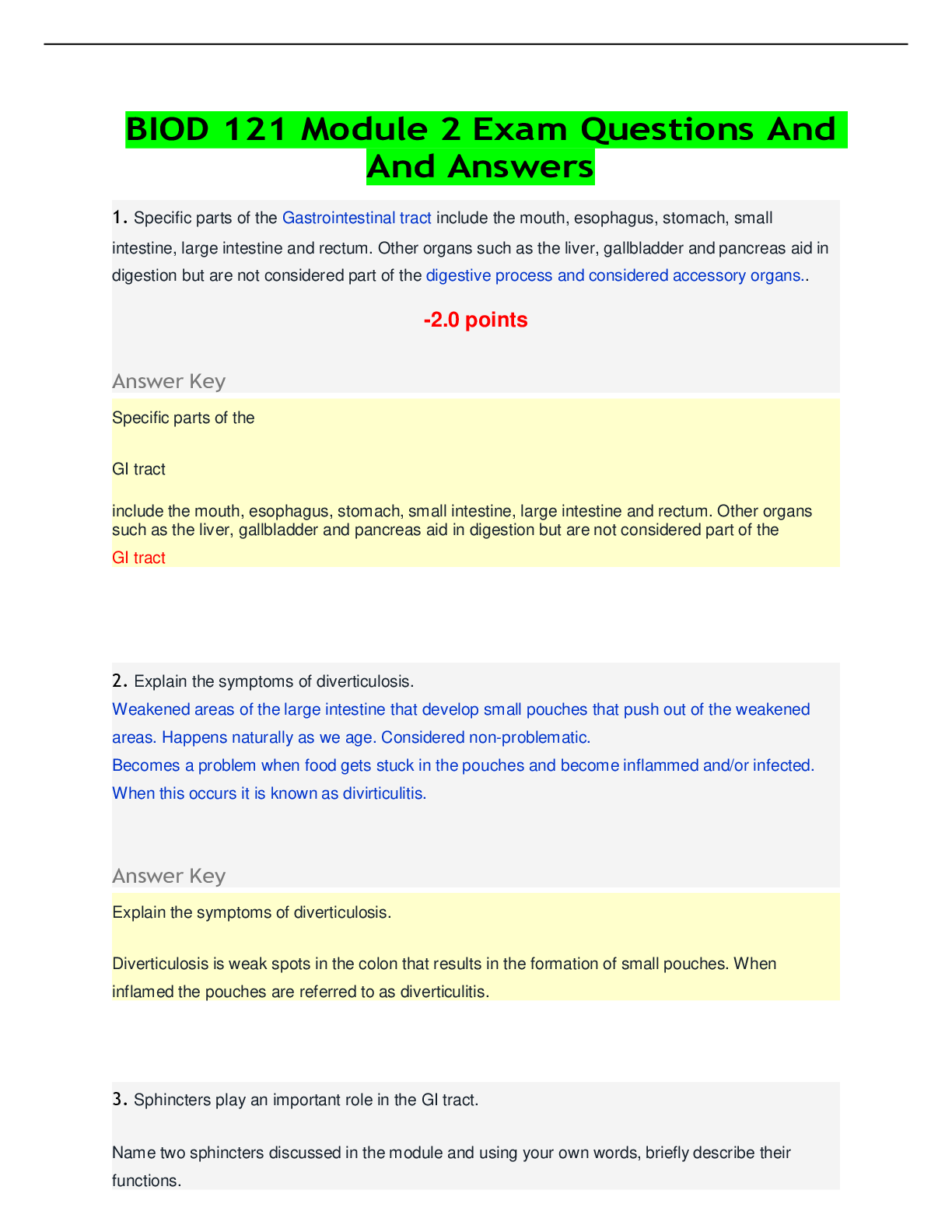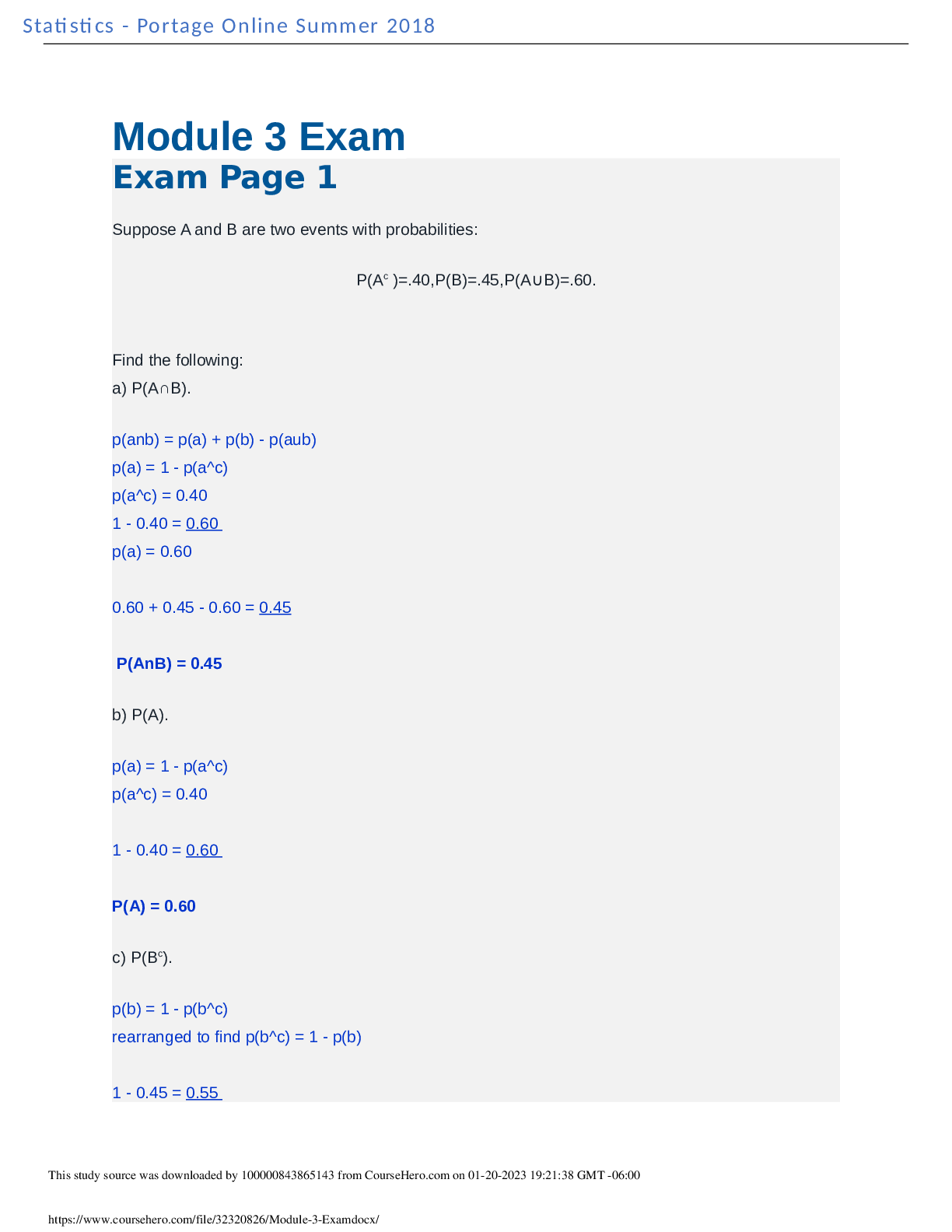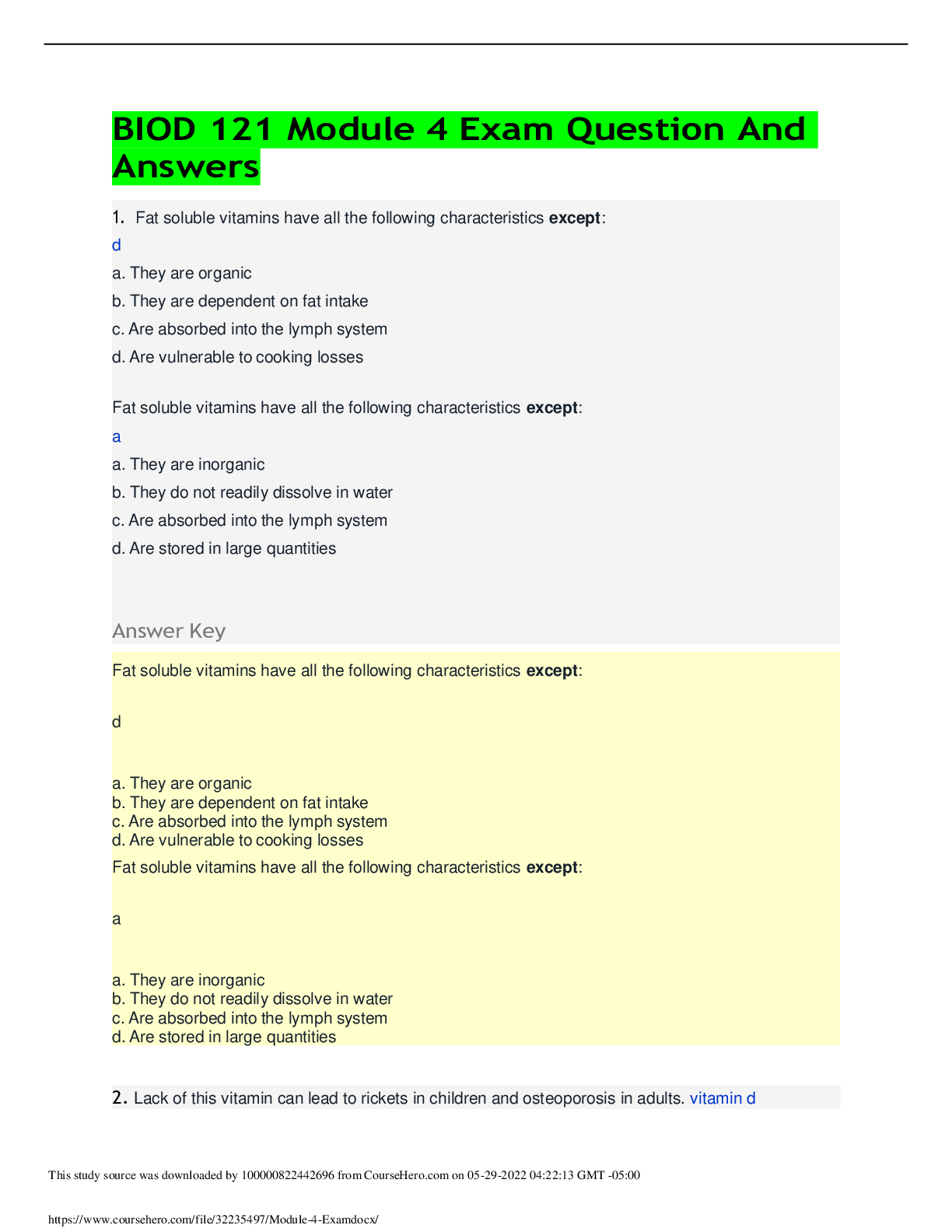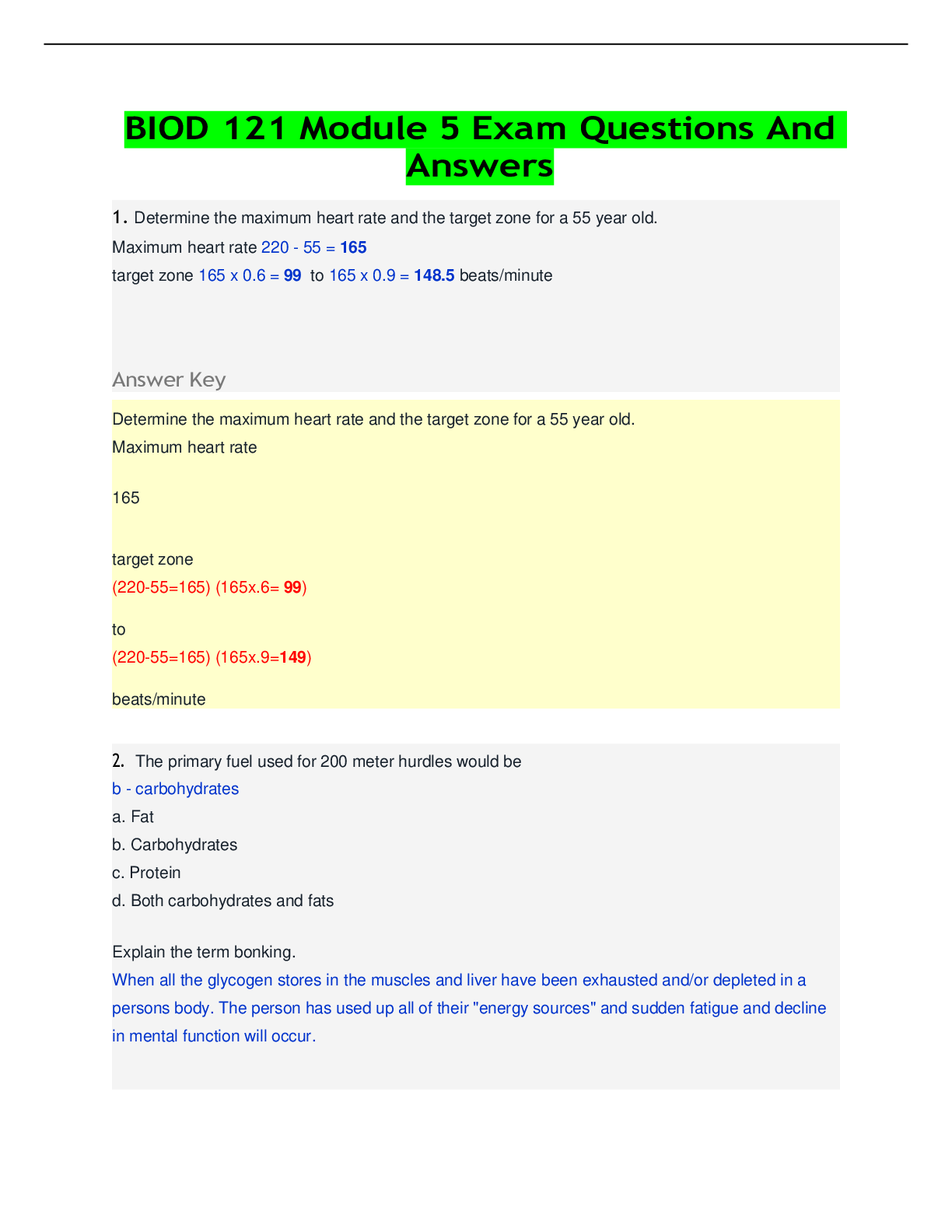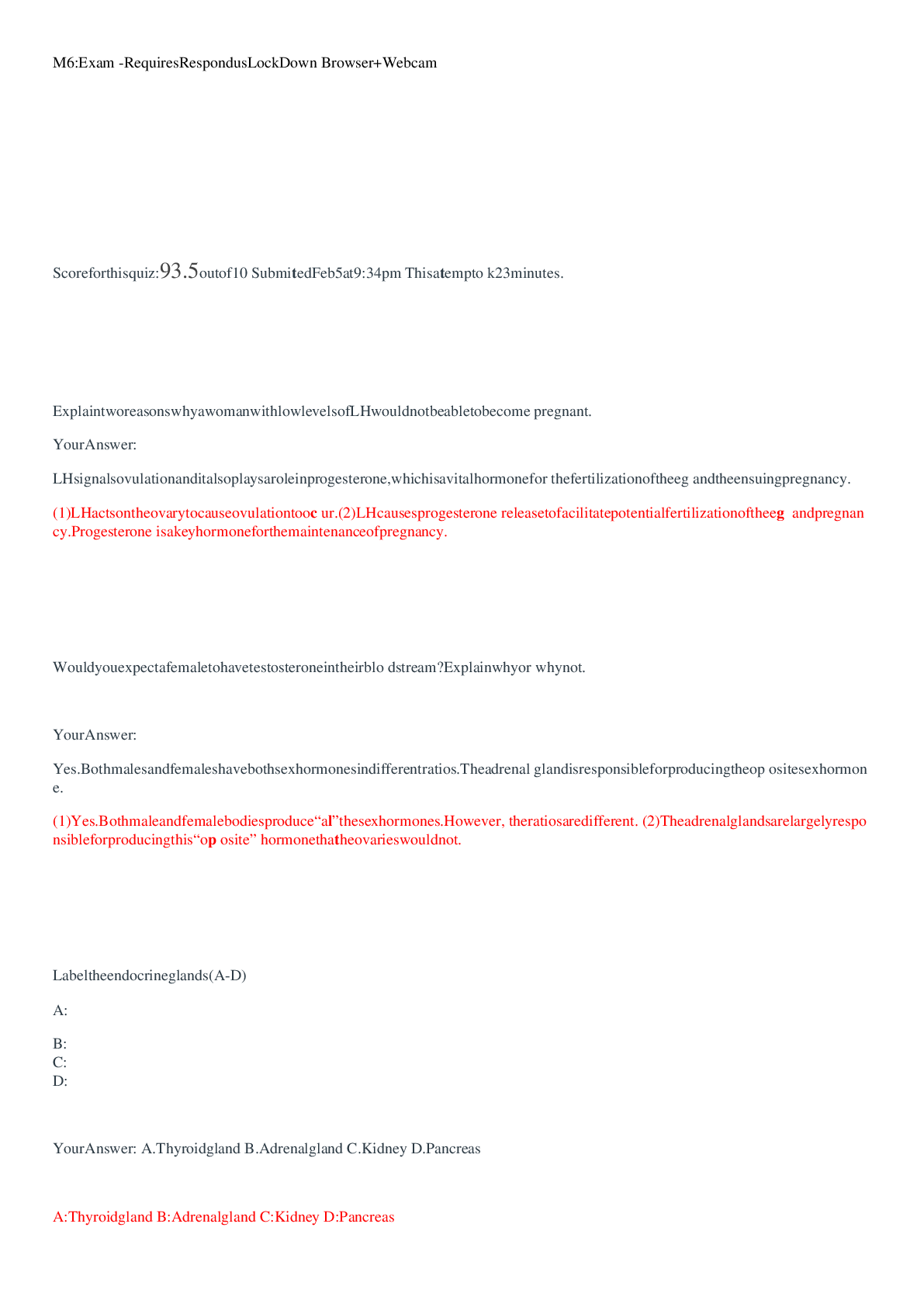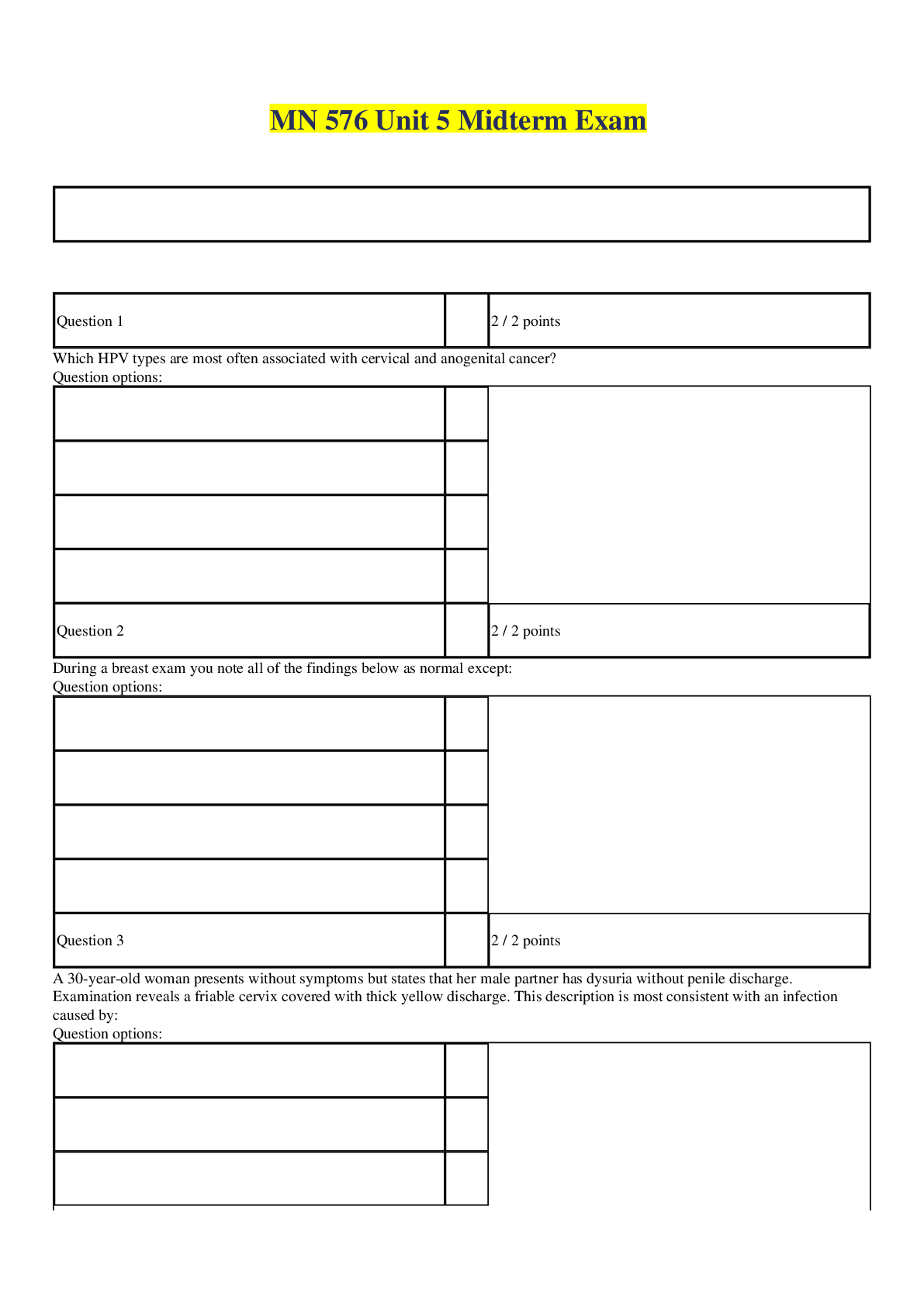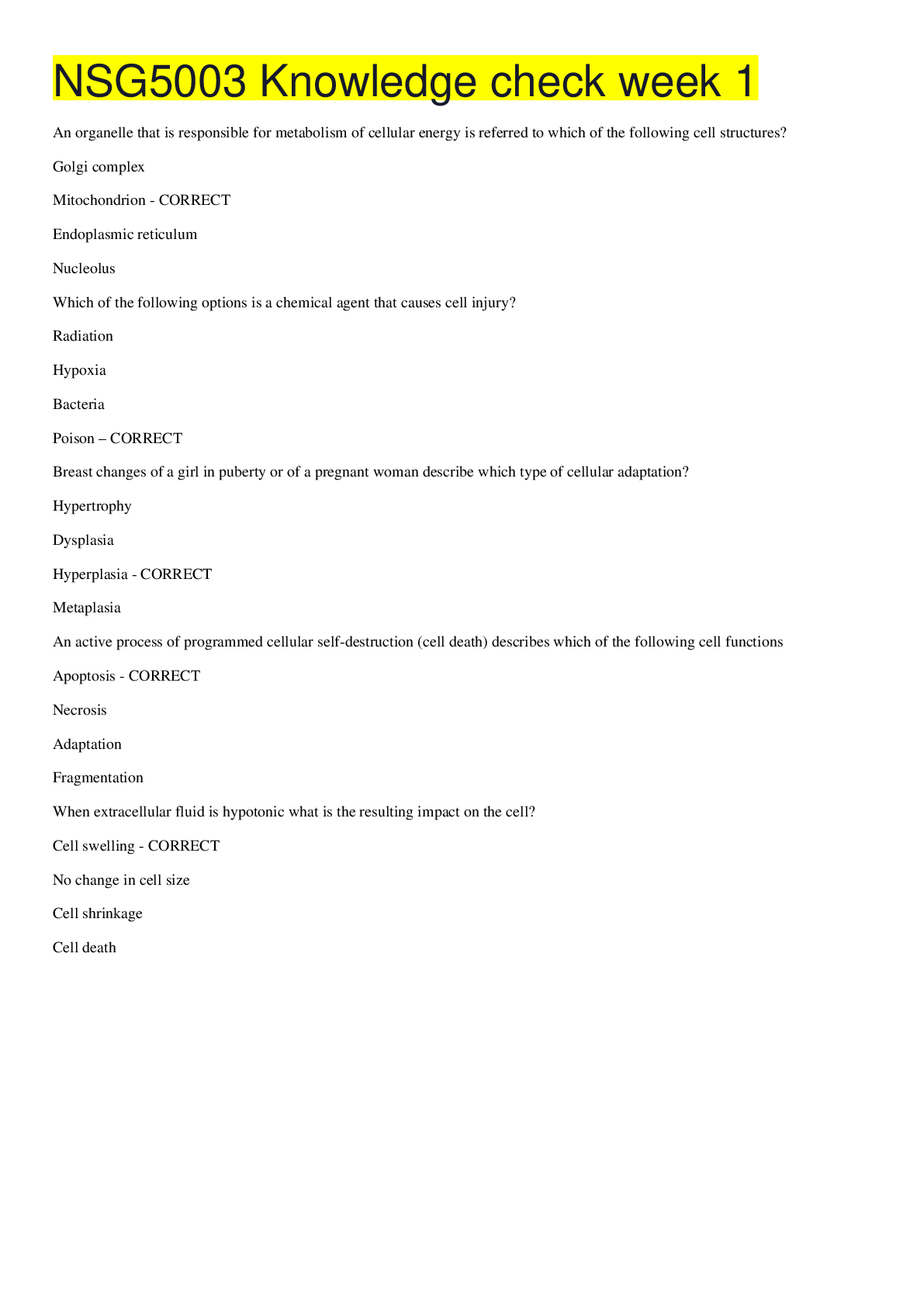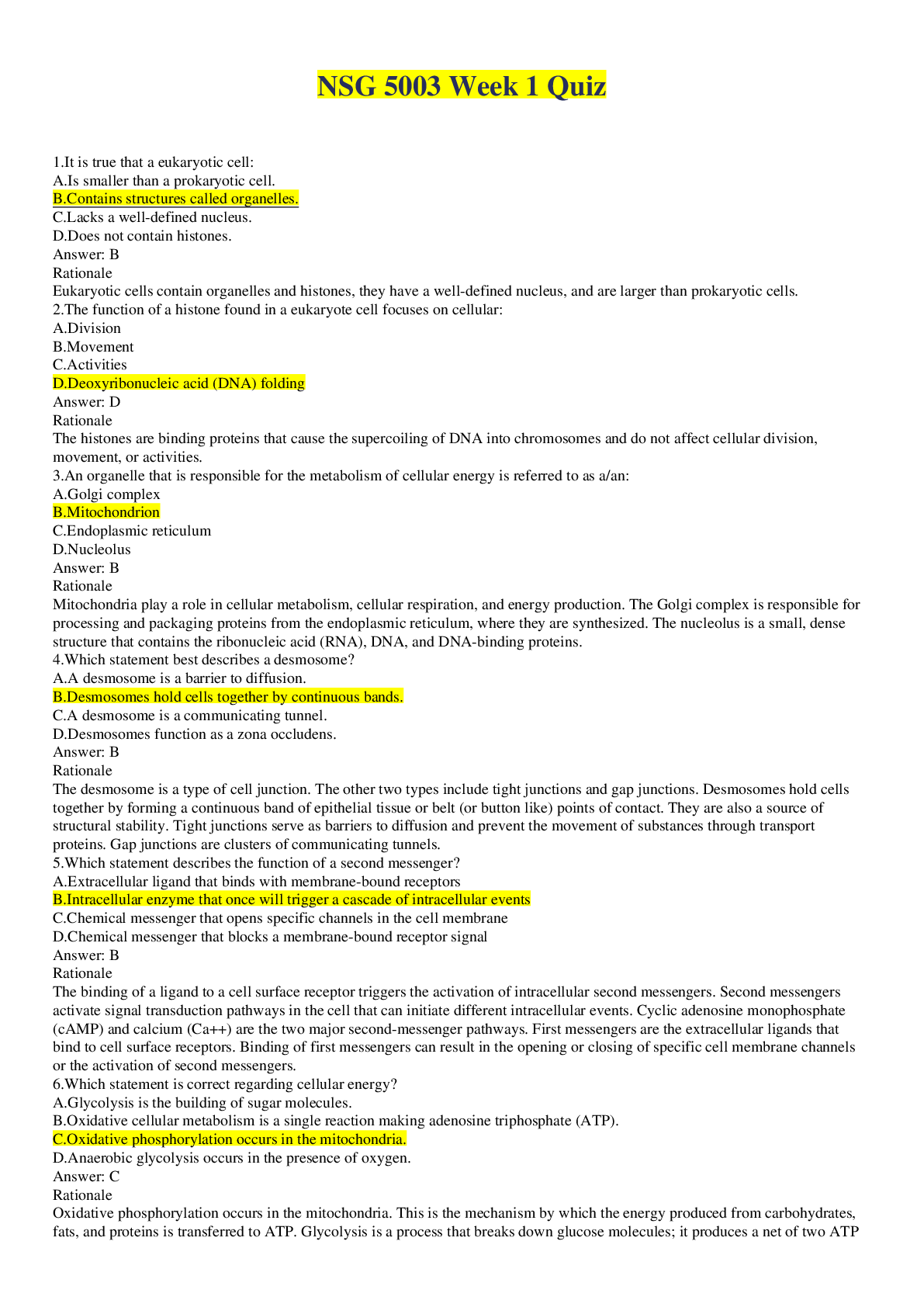Milestone 3.docx/DOWNLOAD TO SCORE A
Document Content and Description Below
1 David is playing a game where he flips two coins and counts the total number of heads. The possible outcomes and probabilities are shown in the probability distribution below. What is the exp... ected value for the number of heads from flipping two coins? 2 Using this Venn diagram, what is the probability that event A or event B occurs? 3 Two sets A and B are shown in the Venn diagram below. Which statement is FALSE? 4 For a math assignment, Michelle rolls a set of three standard dice at the same time and notes the results of each trial. What is the total number of outcomes for each trial? 5 Using the Venn Diagram below, what is the conditional probability of event B occurring, assuming event A has happened [P(B|A)]? 6 John makes random guesses on his multiple-choice test, which has five options for each question. Let the random variable X be the number of guesses taken before guessing correctly. Assuming the guesses are independent, find the probability that he doesn't guess correctly until his 6th guess. 7 A bag contains 8 red marbles, 7 blue marbles, and 6 green marbles. Adam randomly picks out a marble from the bag. What is the theoretical probability that Adam will pick a blue marble from the bag? 8 Joseph selects a card from a standard deck of 52 cards and then replaces it afterwards. He decides to record the total number of red cards that he selects and calculates the proportion of red cards that he has selected so far after each pick. He then constructs a graph to visualize his results. Which of the following statements is FALSE? For a given number of selections, we can use Joseph's graph to find the number of diamonds that he has picked so far. • The relative frequency of selecting a red card changes with the increase in number of selections. • The theoretical probability for selecting a red card in each pick is 0.5. RATIONALE Since we are only graphing the proportion of red cards, there is no information in the sampling distribution about the actual suit of the card. CONCEPT Law of Large Numbers/Law of Averages 9 Luke went to a blackjack table at the casino. At the table, the dealer has just shuffled a standard deck of 52 cards. Luke has had good luck at blackjack in the past, and he actually got three blackjacks with Queens in a row the last time he played. Because of this lucky run, Luke thinks that Queens are the luckiest card. The dealer deals the first card to him. In a split second, he can see that it is a face card, but he is unsure if it is a Queen. What is the probability of the card being a Queen, given that it is a face card? Answer choices are in a percentage format, rounded to the nearest whole number. RATIONALE The probability of it being a Queen given it is a Face card uses the conditional formula: Note that there are 12 out of 52 that are face cards. Of those 12 cards, only 4 of them are also Queens. CONCEPT Conditional Probability 10 Which of the following situations describes a discrete distribution? RATIONALE A distribution is discrete if the outcomes we are measuring can only take on a limited number of values. The number of babies in an intensive care unit can be 0, 1, 2, and so on, which are a limited set of values. CONCEPT Probability Distribution 11 A survey asked 1,000 people which magazine they preferred, given three choices. The table below breaks the votes down by magazine and age group. If a survey is selected at random, what is the probability that the person voted for "Newsday" and is also age 40 or older? Answer choices are rounded to the hundredths place. 0.23 • 0.34 • 0.66 • 0.54 RATIONALE If we want the probability of people who voted for "Newsday" and are also age 40 and over, we just need to look at the box that is associated with both categories, or 230. To calculate the probability, we can use the following formula: CONCEPT Two-Way Tables/Contingency Tables 12 Mark looked at the statistics for his favorite baseball player, Jose Bautista. Mark looked at seasons when Bautista played 100 or more games and found that Bautista's probability of hitting a home run in a game is 0.173. If Mark uses the normal approximation of the binomial distribution, what will be the variance of the number of home runs Bautista is projected to hit in 100 games? Answer choices are rounded to the tenths place. RATIONALE In this situation, we know: n = sample size = 100 p = success probability = 0.173 We can also say that q, or the complement of p, equals: q = 1 - p = 1 - 0.173 = 0.827 The variance is equivalent to n*p*q: CONCEPT Normal Distribution Approximation of the Binomial Distribution 13 What is the probability of drawing a spade or a jack from a standard deck of 52 cards? • • • • RATIONALE Since it is possible for a card to be a spade and a jack, these two events are overlapping. We can use the following formula: In a standard deck of cards, there are 13 cards that have Spade as their suit, so . There is a total of 4 Jacks, so . Of the 4 Jacks, only one is spade so . CONCEPT "Either/Or" Probability for Overlapping Events 14 La'Vonn rolled a die 100 times. His results are below. What is the relative frequency for La'Vonn rolling a 3? Answer choices are rounded to the hundredths place. RATIONALE The relative frequency of a 3 is: CONCEPT Relative Frequency Probability/Empirical Method 15 Zhi and her friends moved on to the card tables at the casino. Zhi wanted to figure out the probability of drawing a face card or an Ace. Choose the correct probability of drawing a face card or an Ace. Answer choices are in the form of a percentage, rounded to the nearest whole number. RATIONALE Since the two events, drawing a face card and drawing an ace card, are non- overlapping, we can use the following formula: CONCEPT "Either/Or" Probability for Non-Overlapping Events 16 Which of the following is an example of a false positive? RATIONALE Since the test results indicate positively that the patient has cancer, when in fact cancer is not present, this is a false positive. CONCEPT False Positives/False Negatives 17 Kendra was trying to decide which type of frozen yogurt to restock based on popularity: flavors with chocolate or flavors without chocolate. After studying the data, she noticed that chocolate flavors sold best on the weekdays and on the weekends, but not best overall. Which paradox has Kendra encountered? Simpson's Paradox • False Negative RATIONALE This is an example of Simpson's paradox, which is when the trend overall is not the same that is examined in smaller groups. Since the sale of chocolate flavors is larger on the weekends, but this trend changes when looking at sales overall, this is a reversal of the trend. CONCEPT Paradoxes 18 The average number of babies born at a private hospital's maternity wing is 6 per hour. What is the probability that three babies are born during a particular 1-hour period in this maternity wing? RATIONALE Since we are finding the probability of a given number of events happening in a fixed interval when the events occur independently and the average rate of occurrence is known, we can use the following Poisson distribution formula: The variable k is the given number of occurrences, which in this case, is 3 babies. The variable λ is the average rate of event occurrences, which in this case, is 6 babies. CONCEPT Poisson Distribution 19 Which of the following is a property of binomial distributions? • All of the observations made are dependent of each other. • The variable of interest is the total number of successes or failures for a given number of observations. • There are exactly four possible outcomes for each trial. • The expected value is equal to the number of successes in the experiment. RATIONALE Recall that for the binomial distribution we are concerned with an event occurring (successes) or not occurring (failures) in a given number of trails (n). CONCEPT Binomial Distribution 20 Annika was having fun playing poker. She needed the next two cards dealt to be diamonds so she could make a flush (five cards of the same suit). There are 15 cards left in the deck, and five are diamonds. What is the probability that the two cards dealt to Annika (without replacement) will both be diamonds? Answer choices are in percentage format, rounded to the nearest whole number. RATIONALE If there are 15 cards left in the deck with 5 diamonds, the probability of being dealt 2 diamonds if they are dealt without replacement means that we have dependent events because the outcome of the first card will affect the probability of the second card. We can use the following formula: The probability that the first card is a diamond would be 5 out of 15, or . The probability that the second card is a diamond, given that the first card was also a diamond, would be because we now have only 14 cards remaining and only 4 of those cards are diamond (since the first card was a diamond). So we can use these probabilities to find the probability that the two cards will both be diamonds: CONCEPT "And" Probability for Dependent Events 21 Three hundred students in a school were asked to select their favorite fruit from a choice of apples, oranges, and mangoes. This table lists the results. If you were to choose a boy from the group, what is the probability that mangoes are his favorite fruit? Answer choices are rounded to the hundredths place. RATIONALE The probability of a person picking mangoes as his favorite fruit given he is a boy is a conditional probability. We can use the following formula: Remember, to find the total number of boys, we need to add all values in this column: 66 + 52 + 40 = 158. CONCEPT Conditional Probability and Contingency Tables 22 What is the probability of NOT drawing a Queen from a standard deck of 52 cards? • • • • RATIONALE Recall that the probability of a complement, or the probability of something NOT happening, can be calculated by finding the probability of that event happening, and then subtracting from 1. Note that there are a total of 4 Queen cards in a standard deck of 52 cards. So the probability of NOT getting a Queen is equivalent to: CONCEPT Complement of an Event 23 Tim rolls two six-sided dice and flips a coin. All of the following are possible outcomes, EXCEPT: 1, Tails, 6 • Heads, 3, 4 • 2, 8, Heads RATIONALE Recall that a standard coin has two values, {Heads or Tails}, while a standard die has six values {1, 2, 3, 4, 5, or 6}. So, obtaining a 2 is possible, however the 8 is not. CONCEPT Outcomes and Events 24 John is playing a game with a standard deck of playing cards. He wants to draw a jack on the first try. Which of the following statements is true? RATIONALE Events are said to be independent if one event does not influence the likelihood of the other. Since John re-shuffles the deck and puts the card back in the deck, the probability should be the same and the first draw will not influence the second. CONCEPT Independent vs. Dependent Events 25 Eric is randomly drawing cards from a deck of 52. He first draws a red card, places it back in the deck, shuffles the deck, and then draws another card. What is the probability of drawing a red card, placing it back in the deck, and drawing another red card? Answer choices are in the form of a percentage, rounded to the nearest whole number. RATIONALE Since Eric puts the card back and re-shuffles, the two events (first draw and second draw) are independent of each other. To find the probability of red on the first draw and second draw, we can use the following formula: Note that the probability of drawing a red card is or for each event. CONCEPT "And" Probability for Independent Events 26 Peter randomly draws a card from a deck of 24. The odds in favor of his drawing a spade from the cards are 1:3. What is the probability ratio for Peter to draw a spade? • • • • RATIONALE Recall that we can go from " " odds to a probability by rewriting it as the fraction " ". So odds of 1:3 is equivalent to the following probability: CONCEPT Odds 27 Select the following statement that describes non- overlapping events. RATIONALE Events are non-overlapping if the two events cannot both occur in a single trial of a chance experiment. Since he wants a face card {Jack, Queen or King} and he got an eight {8}, there is no overlap. CONCEPT Overlapping Events © 2020 SOPHIA Learning, LLC. SOPHIA is a registered trademark of SOPHIA Learning, LLC. [Show More]
Last updated: 2 years ago
Preview 1 out of 18 pages
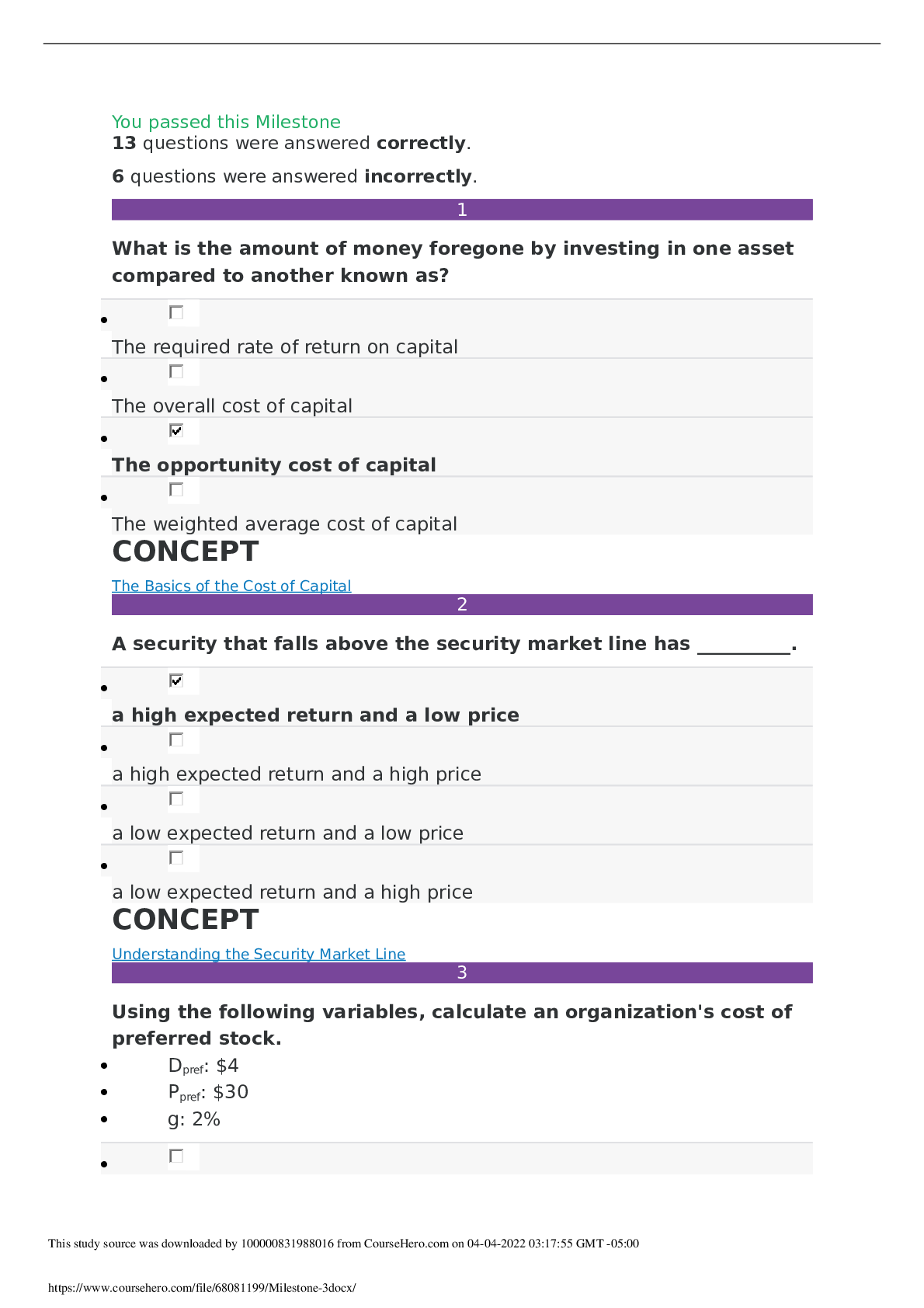
Buy this document to get the full access instantly
Instant Download Access after purchase
Buy NowInstant download
We Accept:

Reviews( 0 )
$14.50
Can't find what you want? Try our AI powered Search
Document information
Connected school, study & course
About the document
Uploaded On
Jul 24, 2021
Number of pages
18
Written in
Additional information
This document has been written for:
Uploaded
Jul 24, 2021
Downloads
0
Views
124


